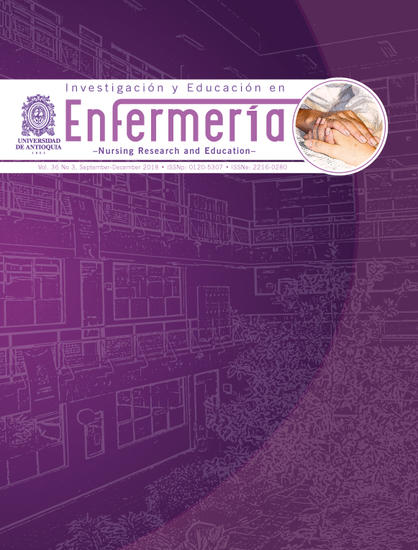Validation of the Work Limitations Questionnaire in Brazilian Army military personnel
DOI:
https://doi.org/10.17533/udea.iee.v36n3e06Keywords:
Occupational health, military personnel, validation studies, psychometrics.Abstract
Objective To validate the Work Limitations Questionnaire (WLQ) to measure presenteeism in Brazilian military personnel.
Methods This is a test validation study conducted with 125 individuals of a military staff attending a Brazilian Army Unit. We applied a form with demographic and occupational variables and the WLQ, composed of 25 items. The construct validity was assed trough confirmatory factorial analysis.
Results We confirmed the interdependent structure of the WLQ´s domains for explaining the presenteeism of the sample in four domains: outcome demand, mental demand, physical demand and time management. Most of items showed factorial loads between 0.5 and 0.7 and the adjustment (absolute and incremental) and residues indexes demonstrated satisfactory values. The Alphas in domains ranged from 0.68 (output demand) to 0.79 (time management) in domains, evidencing reliability for the WLQ.
Conclusion We confirm the construct validity of the WLQ to assess presenteeism in Brazilian military staff.
How to cite this article: Umann J, Silva RM, Kimura CA, Lopes VC, Guilhem DB. Validation of the Work Limitations Questionnaire in Brazilian Army military personnel. Invest. Educ. Enferm. 2018; 36(3):e06.
Downloads
References
(1) Biron C, Saksvik O. Sickness Presenteeism and Attendance Pressure Factors: Implications for Practice. In: Cooper CL, Quick JC, Schabracq MJ, Editors. International Handbook of Work and Health Psychology. Nova Jersey: Wiley-Blackwell; 2009. p.77-92.
(2) Aronsson G, Gustafsson K, Dallner M. Sick but yet at work. An empirical study of sickness presenteeism. J epidemiol community health. 2000; 54(7):502–09.
(3) Johns G. Presenteeism in the workplace: a review and research agenda. J. Organiz. Behav. 2010; 31(4):519-42.
(4) Cheryl I. AMA Manual of Style: A Guide for Authors and Editors. Oxford: Oxford University Press; 2016. Work Limitations Questionnaire: Publications and Presentations.10th ed. Oxford: Oxford UP; 2016.
(5) Baptista PCP, Pustiglione M, Almeida MCS, Felli VEA, Garzin ACA, Melleiro MM. Nursing workers health and patient safety: the look of nurse managers. Rev. Esc. Enferm. USP. 2015; 49(n.spe2):122-8.
(6) Umann J, Guido LA, Silva RM. Stress, coping and presenteeism in nurses assisting critical and potentially critical patients. Rev. Esc. Enferm. USP. 2014; 48(5):891-8.
(7) Arumugam V, MacDermid JC. The Work Limitations Questionnaire (WLQ-25). J. Phys. 2013; 59(4):276.
(8) Simmons A, Yoder L. Military resilience: a concept analysis. Nurs. Forum. 2013; 48(1):17-25.
(9) D'Errico A, Viotti S, Baratti A, Mottura B, Barocelli AP, Tagna M, et al. Low back pain and associated presenteeism among hospital nursing staff. J. Occup. Health. 2013; 55(4):276-83.
(10) Ospina MB, Dennett L, Waye A, Jacobs P, Thompson AH. A Systematic Review of Measurement Properties of Instruments Assessing Presenteeism. Am. J. Manag. Care. 2015 ;21(2):171-85.
(11) Lerner D, Amick BC, Rogers WH, Malspeis S, Bungay K, Cynn D. The Work Limitations Questionnaire. Med. Care. 2001; 39(1):72–85.
(12) Koopman C, Pelletier KR, Murray JF, Sharda CE, Berger ML, Turpin RS, et al. Stanford Presenteeism Scale: health status and employee productivity. J. Occup. Environ. Med. 2002; 44(1):14-20.
(13) Soárez PC, Kowalski CCG, Ferraz MB, Ciconelli RM. Tradução para português brasileiro e validação de um questionário de avaliação de produtividade. Rev. Panam. Salud Pública. 2007; 22(1):21–8.
(14) Paschoalin HC, Griep RH, Lisboa MTL, Mello DCB. Adaptação transcultural e validação para o português brasileiro do Stanford Presenteeism Scale para avaliação do presenteísmo. Rev. Latino-Am. Enfermagem. 2013; 21(1):388-95.
(15) Umann J, Guido LA, Grazziano ES. Presenteeism in hospital nurses. Rev. Latino-Am. Enfermagem. 2012; 20(1):159-66.
(16) Hulley SB, Cumming SR, Browner WS, Grady DG, Hearst NB, Newman TB. Delineando a pesquisa clínica: uma abordagem epidemiológica. Porto Alegre; Artmed; 2008.
(17) Damasio BF. Contribuições da análise fatorial confirmatória multigrupo (AFCMG) na avaliação de invariância de instrumentos psicométricos. Psico. USF. 2013; 18(2):211-20.
(18) Hair JF, Black WC, Babin BJ, Anderson RE, Tatham RL. Análise Multivariada de Dados. 6. ed. Porto Alegre: Bookman, 2009.
(19) Pilati R, Laros JA. Modelos de Equações Estruturais em Psicologia: Conceitos e Aplicações. Psic. Teor. Pesq. 2007; 23(2):205-16.
Downloads
Published
How to Cite
Issue
Section
License
Derechos de propiedad / Direitos de Propriedade
English: If the article is accepted for publication, all copyright will be of exclusive property of Investigación y Educación en Enfermería. The text and the graphics included in the publication are exclusive responsibility of the authors and not necessarily reflect the thought of the Editorial Committee.
Español: Si el artículo es aprobado para publicación, todos los derechos son de propiedad de Investigación y Educación en Enfermería. El texto y las gráficas incluidas en la publicación son de exclusiva responsabilidad de los autores y no necesariamente refleja el pensamiento del Comité Editorial.
Português: Se o artigo for aceito para publicação, todos os direitos autorais serão de propriedade exclusiva de Investigación y Educación en Enfermería. O texto e os gráficos incluídos na publicação são de responsabilidade exclusiva dos autores e não refletem necessariamente o pensamento do Comitê Editorial.















